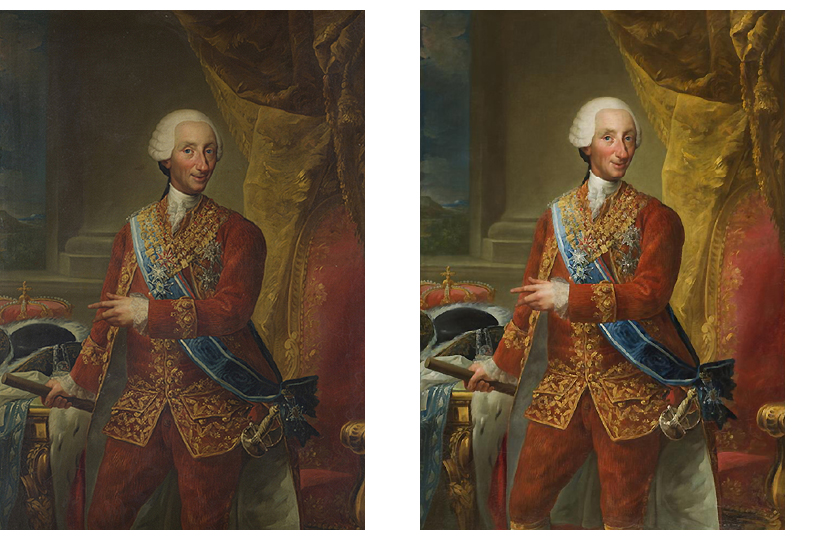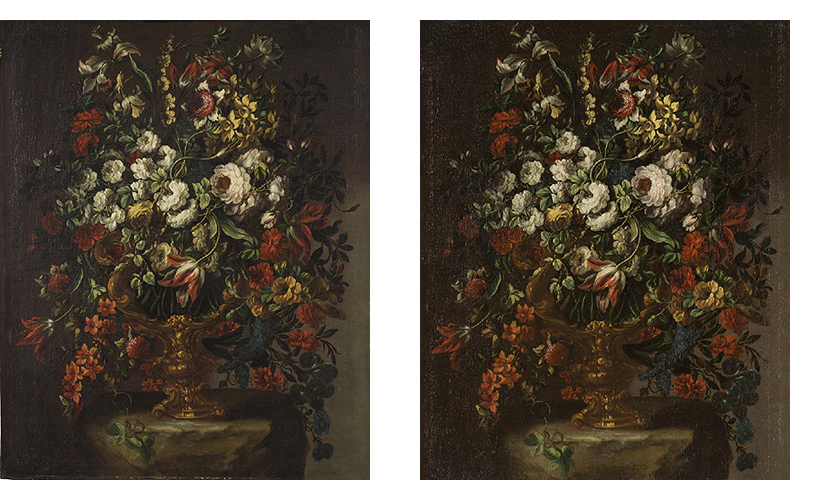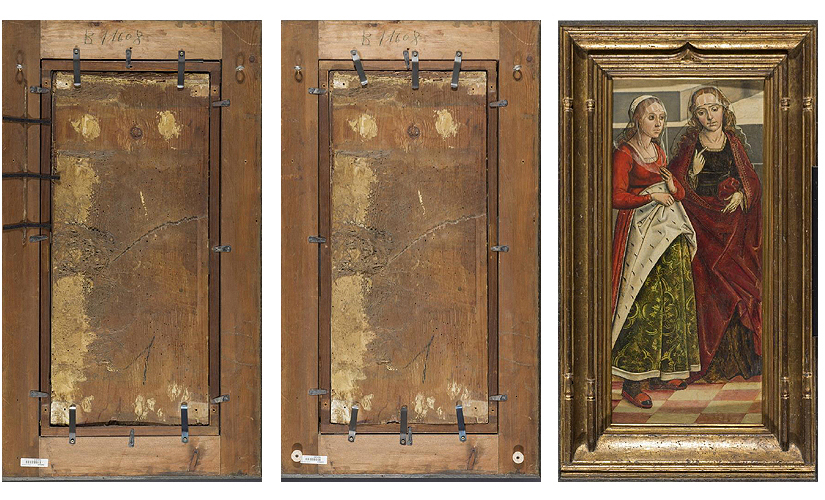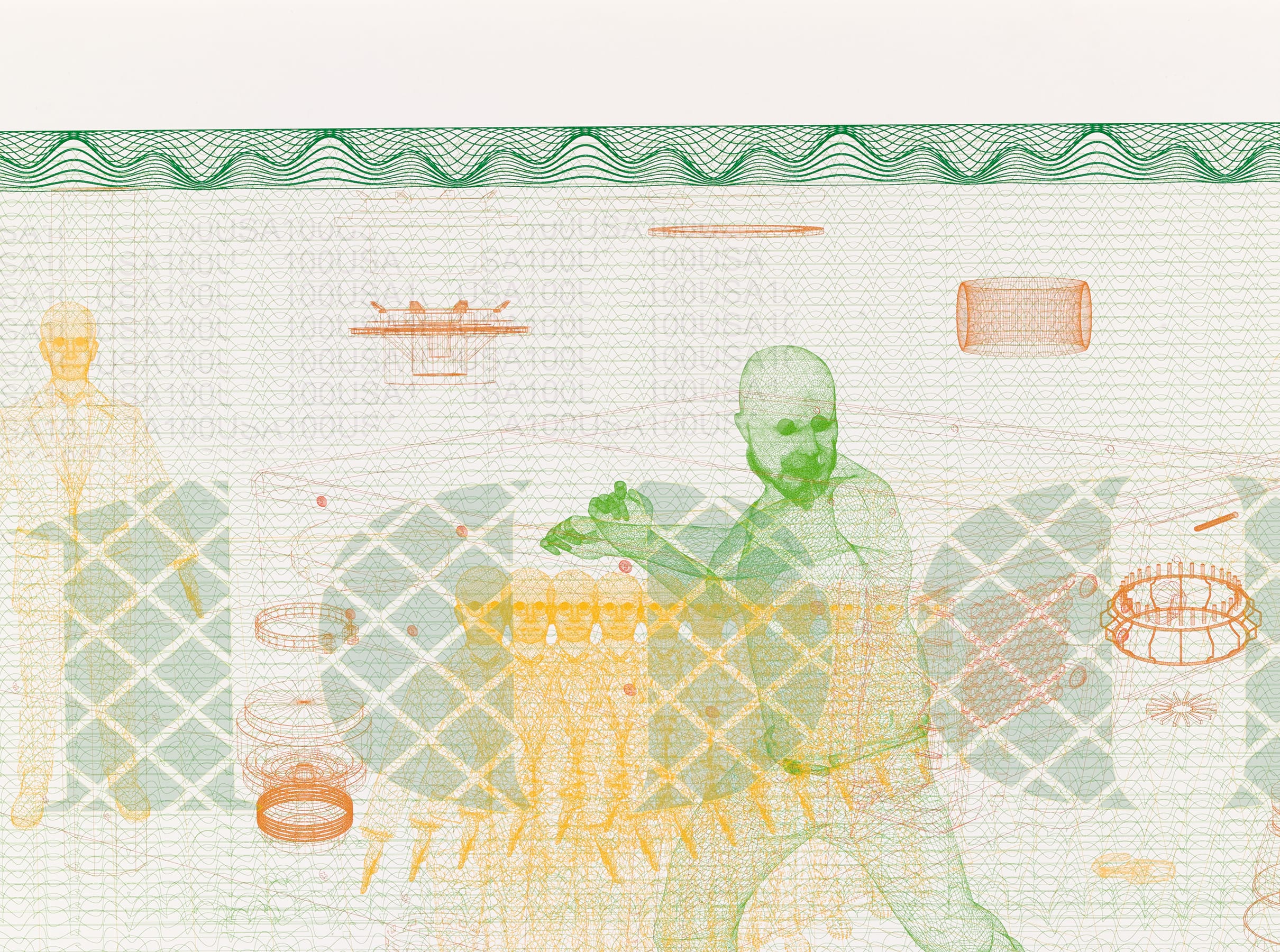
Several works from Banco de España Collection restored at Museo del Prado workshops
Four major works from our classical collection have recently been restored at the workshops of the Museo del Prado![]() (Prado Museum) under our cooperation agreement with them. The works in question are the small panel Two Female Figures, painted circa 1500 at the Studio of Pedro Berruguete, two paintings of vases of flowers probably painted in Madrid between 1660 and 1690, and a portrait of King Charles III by Valencia-born artist Mariano Salvador Maella, dated 1783.
(Prado Museum) under our cooperation agreement with them. The works in question are the small panel Two Female Figures, painted circa 1500 at the Studio of Pedro Berruguete, two paintings of vases of flowers probably painted in Madrid between 1660 and 1690, and a portrait of King Charles III by Valencia-born artist Mariano Salvador Maella, dated 1783.
In all four cases the restoration was to repair minor structural problems and ensure that the works are stable and fit for display. The pictures of the vases and the portrait by Maella were restored by Eva María Martínez Morales. The Berruguete panel, where the main problem was a misalignment in the frame that could have caused deterioration in the backing material and which required the work to be re-mounted, was handled by José de la Fuente Martínez, a specialist in frames at the Prado workshops.
 Portrait of King Charles III (Mariano de Salvador Maella, 1783), before and after restoration
Portrait of King Charles III (Mariano de Salvador Maella, 1783), before and after restoration
The Banco Nacional de San Carlos![]() (regarded as the earliest forerunner of the Banco de España) was founded during the reign of Charles III. This portrait, acquired in 1968, was initially attributed to Anton Raphael Mengs
(regarded as the earliest forerunner of the Banco de España) was founded during the reign of Charles III. This portrait, acquired in 1968, was initially attributed to Anton Raphael Mengs![]() , because Mariano Salvador Maella modelled his depiction of the king, especially the face, on Mengs' portrait
, because Mariano Salvador Maella modelled his depiction of the king, especially the face, on Mengs' portrait![]() of him from 1764, which is now owned by the Prado. Maella portrays the king dressed in red velvet with rich gold embroidery, holding his military staff of command. In contrast with the sober setting of Mengs' original portrait, Maella chose a gentler background to highlight the image of the king as an approachable figure, a father to his subjects and an example of good governance. The warm colours used by Maella make this a highly attractive portrait. Manuela Mena writes that this impression is further reinforced by his use of thickly layered paint to produce highlighted reliefs that enrich and animate the surface of the canvas.
of him from 1764, which is now owned by the Prado. Maella portrays the king dressed in red velvet with rich gold embroidery, holding his military staff of command. In contrast with the sober setting of Mengs' original portrait, Maella chose a gentler background to highlight the image of the king as an approachable figure, a father to his subjects and an example of good governance. The warm colours used by Maella make this a highly attractive portrait. Manuela Mena writes that this impression is further reinforced by his use of thickly layered paint to produce highlighted reliefs that enrich and animate the surface of the canvas.
This restoration has repaired the problems in the tensioning of the backing fabric of the work, stabilising the bulges in some parts of the painted surface that were accentuating its craquelure. At the same time the colours were restored to their original hues and brightness.
 Vases (anonymous, Spanish 1660 & 1670), before and after restoration
Vases (anonymous, Spanish 1660 & 1670), before and after restoration
The restored pictures of vases date from the 1660s and 1670s. On their acquisition by the Banco de España they were attributed to Gabriel de la Corte, a little-known artist who worked in Madrid in the second half of the 17th century. However, this cannot be confirmed, because although they resemble other works known to be by him, they also show subtle differences in character, technique and colouring. It is, however, clear that they were painted by someone who, like Gabriel de la Corte, was closely linked to the Madrid art scene of that time, where there was a strong Italian influence. Alfonso Pérez Sánchez writes that this explains why these two works, which underwent earlier restorations which could not claim to be successful, owe so much in terms of style to artists such as Mario Nuzzi from Rome, regarded as the master of flower painting, and Andrea Belvedere of Naples.
The restoration work done here has focused on correcting certain alterations in the appearance of the works which, in the words of Eva María Martínez Morales, distorted the reading and appreciation of both canvases. For example, work has been done on gaps and areas where the paint had been lost, some as large as 4 cm across, and the varnish has been evened out.
 Frame of the panel Two Female Figures (Studio of Pedro Berruguete), before and after restoration. Obverse of the panel Two Female Figures (Studio of Pedro Berruguete), before and after restoration.
Frame of the panel Two Female Figures (Studio of Pedro Berruguete), before and after restoration. Obverse of the panel Two Female Figures (Studio of Pedro Berruguete), before and after restoration.
The oldest work restored here is a small panel that portrays two female figures. In her itinerary on the body, based on works from the Collection, writer Marta Sanz describes them as engaged in the noble art of conversation. This panel is almost certainly a fragment of an altarpiece showing a scene from the life of the Virgin Mary, produced at the studio of Pedro Berruguete. This panel has various new features characteristic of the Renaissance style in its perspective, its concept of space, the way in which the anatomy of the figures is drawn and the delicacy of their gestures. This style was first introduced into Spain by Berruguete, who trained in Italy for several years. The panel was probably not painted by the master himself but by others working at his studio, which handled numerous commissions in his later years.
The panel is well preserved, but was suffering from a misalignment in its mounting. Its restoration has therefore consisted mainly of re-mounting it to eliminate play in the frame and ensure that the panel is secure and not under such strain that it might crack.
